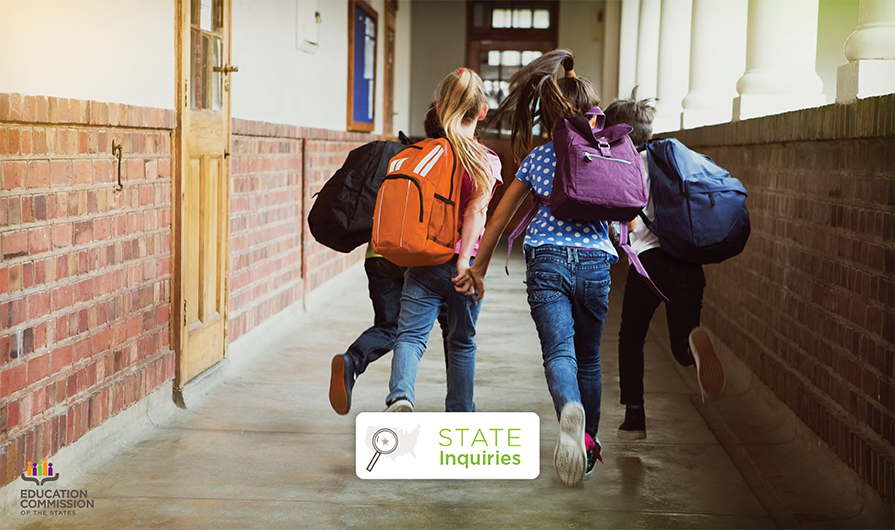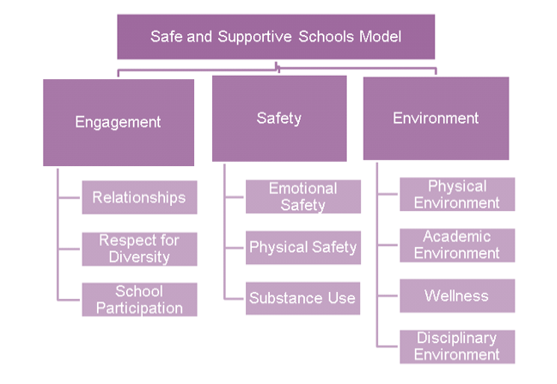States want to ensure students and teachers feel safe and supported in classrooms and schools. There are countless ways education leaders try to make this happen, and many fall into what is often considered school climate, or the quality and character of school life. We have found that policymakers asking questions about school climate tend to focus on the overlapping areas of mental health, school discipline and physical safety. If you’re a policymaker exploring school climate issues in your state, here is some context that may help.
School Climate
Research shows that positive school climate is tied to better attendance rates, test scores, promotion rates and graduation rates. Conversely, negative school climate may lead to lower student achievement, poor student engagement, low graduation rates and increased disciplinary issues. According to the Safe and Supportive School Model, which was developed by a national panel of researchers and other experts, positive school climate involves several overlapping areas of focus:
Mental Health
Research suggests that school-based mental health services can play a role in reducing mental health challenges among students, particularly those who might not have access to these services outside of school. While there are several ways to support student mental health in school settings, recent state policies have been primarily focused on:
- Providing school-based mental health professionals.
- Utilizing trauma-informed practices.
- Incorporating social and emotional learning.
- Creating greater awareness of mental health issues through curriculum and staff training.
- Implementing supports for suicide prevention.
School Discipline
Several states have implemented strategies to address the disciplinary environment by limiting the use of suspension and expulsion in schools. In place of those punitive strategies, states have started to focus on fostering more supportive school environments in recent years through the use of alternative disciplinary strategies, such as positive behavior interventions, trauma-informed approaches and restorative practices. For more detailed information on current state laws on school discipline, please see our 50-State Comparison: State Policies on School Discipline.
While research on the use of alternative school discipline strategies is still in its nascent stage, these strategies seem to be showing some potential for improving overall school climate — in addition to reducing the use of punitive disciplinary measures. It is crucial to point out, however, that these strategies do not take hold overnight.
Physical Safety
While recent conversations around school safety have primarily focused on preventing school violence, other elements of physical safety are also key to a positive school climate — including up-to-date facilities and location within a community. We have been tracking enacted and vetoed legislation related to school safety for several years in our State Education Policy Tracking resource. Our 50-State Comparison: K-12 School Safety provides an overview of state school safety policies addressing school safety plans, audits, drills, school resource officers and weapons in schools.
According to the National Center on Safe Supportive Learning Environments, “a well-maintained and safe physical environment fosters students’ ability to learn, to show improved achievement scores, and to exhibit appropriate behavior.” Additionally, students may be more receptive to learning in environments with low noise, that are clean, have access to clean air and water, and are not overcrowded. All of these factors have an impact on overall school climate, as well as on students’ physical and mental health. Students are not the only beneficiaries of up-to-date facilities, as physical environment is also related to teachers’ levels of absenteeism, morale and job satisfaction. School facilities are crucial to student learning; however, it is also important to note that schools often inherit the conditions of the surrounding neighborhoods.
We frequently receive questions from policymakers on school climate issues. A full response to a question about the intersection of school climate, mental health, school discipline and school safety — including additional information on state policy — can be found here. If you have a question about any of these issues or other education policy topics, please contact us.








